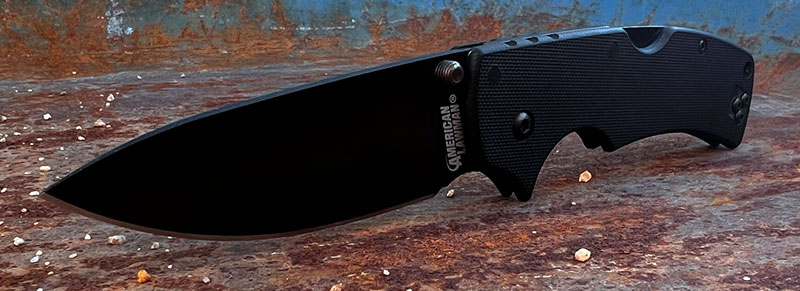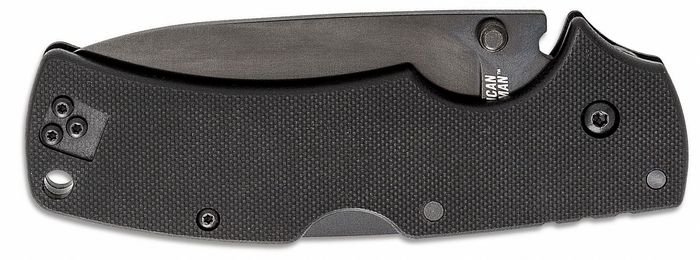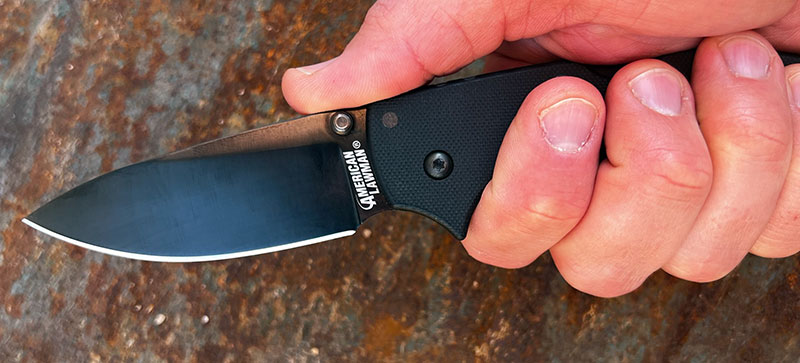We independently evaluate all recommended products and services. Any products or services put forward appear in no particular order. If you click on links we provide, we may receive compensation.

Cold Steel American Lawman
Quality/Performance - 76%
Value for Money - 84%
80%
- Pros: Smooth action, solid lockup, fair price point, ambidextrous, quality materials
- Cons: Lock bar pressure can be difficult, no color options, odd pocket clip for carry
Andrew Demko and Cold Steel are synonymous names in the folding knife world. Before venturing out on his own to make a new line of knives (the AD20 and AD20.5 line), he worked under Cold Steel’s brand as a designer for many of their knives, with an emphasis on the spokesman and testing side of the brand. There have been many that take a place in the hall of fame folders in Cold Steel’s lineup, but the American Lawman is one that seems to remain evergreen through the years. The knife has changed a bit over time, but has remained largely the same, with some very usable features and reliability that rivals knives at a much higher price point, all while keeping the budget on the lower end. Maybe it’s not a knife that every folder connoisseur needs to have in their collection, but maybe we can push to make it a law…. ok, enough with the puns. For now.
Key Specs: Cold Steel American Lawman
Blade
We have arrived to a point in time where folding knives often have more descriptive words to project their looks in words, but the American Lawman keeps it simple. It’s a 3.5” drop point blade, flat ground, with a huge forward choil. Using the mid range S35VN blade steel, and a DLC coating to keep the knife from looking too friendly, the Lawman looks about as plain as a knife blade could look. Of course, Cold Steel has to keep their large text boasting their brand name on the blade, as well as the model name, S35VN, and Taiwan verbiage, but it’s all confined to a small area on either side of the blade near the heel.

With a blade thickness of .13”, it’s somewhat hefty in it’s ability to endure abuse, but not thick enough to cause binding in cuts, or have a blade-to-weight ratio that’s out of proportion. Also, in my experience, Cold Steel seems to put a great, albeit toothy edge on the knife from the factory. I find it quite usable, and much more aggressive in cutting than many other folders with this particular steel out of the box.
Deployment & Lockup
Ah, who else enjoys a traditional back lock? Yeah, I know, not many of us. The good news is, Demko, in his seemingly never-ending idea book for lock designs, hit a home run with the Tri-Ad lock. Yes, it’s a back lock, but has a stop pin that sits between the blade and lock bar, giving the lock a level of reliability and rigidity that rivals any lock on the market. Another point in the Tri-Ad lock’s favor – incredible smoothness. Part of the smooth nature of the Lawman’s deployment is due to good quality phosphor bronze washers in the pivot, but also a polished blade tang that rides along the back lock during the deployment action. It’s the fine details like this, that make me appreciate a folder that’s only ~$125. Yes, there are cheaper knives out there, many with great locks and features, too. But the Lawman is easily justified at this price point (and easily found under $100 on the secondary market).

While there are many positives to the Tri-Ad lock, there are still some arguably less desirable aspects. Yes it’s smooth, but there is no traditional detent to keep the blade closed. This isn’t an inherent problem with back locks in general; it’s more of a preference. But I have to admit, having a nice, crisp detent that keeps the blade closed, and allows the blade to “pop” and slam to the open position, is entirely more enjoyable to a knife nut. I did drop the knife on carpet accidentally one time, and the blade came open more than half way.

Again, this could happen with a standard detent ball folder, but it does seem to happen much more easily on this knife. The second down side to the deployment on a back lock, is being able to flick the knife open in one fell swoop.

Again, preference plays a part in this aspect. The knife slow rolls open with great smoothness and is quite easy on the thumb with a well-designed dual thumb lug. The lock bar is quite stiff, resulting in a firm, long press to allow the blade to disengage from the locked position, but for most users, it’s not overly difficult. And, when that blade is locked in place, it’s extremely tight. No movement in any direction, unless you’re flexing the G10 scales and pivot by means of heavy testing.
Features, Fit & Finish
Speaking of G10 handle scales, the American Lawman uses the G10 scales and does not have liners. The Benchmade Bugout still to this day receives critique for having FRN handle scales with a partial liner, because the scales flex very easily and are not at all comfortable in a tight grip. But G10 is stronger than FRN, and even though Cold Steel went with an ultra thin handle (.39”), the Lawman is still very rigid in the handle. The handle is quite wide, so the thinness doesn’t seem to be a negative in using the knife, but allows it to be carried easily. And with a weight of only 3.9 ounces, it may not “disappear in the pocket”, but it sure does tuck away nicely until you’re ready to use it. And with a handle length of 4.6”, there’s plenty of real estate to keep the knife securely in hand.

But, on a $125 knife, there’s a level of fit and finish that may not quite be satisfactory to some users. The insides of the scale edges are sharp, the body screws are tiny T6 heads, the backspacer doesn’t sit flush with the scales, and the pocket clip isn’t quite perfect. Oddly enough, Cold Steel has manufactured this knife, as they do with many of their folders, to have a curved pocket clip. Which means you need to swap the clip out for a left handed variant if you’re going to carry and use this knife left handed. They do include this second clip in the box, but it’s an odd choice to say the least.

The pocket clip also is very small, and although it has good retention in the pocket, it can be pesky to get it to slide over the lip of a pocket, sometimes requiring a second hand. But all in all, a truly ambidextrous pocket knife with less than perfect quality, this is a well done folder for this price point.
Field Test
Some Cold Steel folders I review, I’ll put through the gauntlet. Like the 4Max Scout, chopping through a 2×4. But the Lawman feels more like a rugged EDC knife, so that’s how I tested it. I really expected the blade to split apple slices upon cutting them, but it didn’t. The edge geometry is just thick enough to be robust and take some torquing action in cutting, but thin enough to slice fruit without splitting it into pieces. The over sized forward choil is nice to use when making heavy push cuts in cardboard or wood, but they left enough handle on the end to be able to hold the knife without using the choil when needed. Either grip works great, and it’s impressive that it was designed to be able to use either one and keep the comfort factor there.

Cutting up sisal rope on the work bench, the S35VN factory edge cut agressively. Something like a Spyderco Paramilitary 2 has some of the best ergos and blade shape for this test in my use, but the Lawman did just fine. I did find myself having a little issue with the handle in one regard though. The point of the G10 on the handle, just before the forward choil, is much more pronounced than necessary. I’m not quite sure why they made it so large, and it has a very close feeling to the Spyderco Manix 2 at this point of the handle.

But to bring another positive to the handle, the finish of the G10 is less aggressive than many other knives, like Emerson’s, for example. This aids in getting the knife in and out of the pocket without too much friction. But then the small pocket clip does hang up sometimes. It’s a game of love and hate, with this odd pairing of features when using this knife. But overall, the Lawman cuts well, slices when needed, opens and closes without too much effort, and locks open like a fixed blade.
Alternatives
All these knives available at BladeHQ.
The Spyderco Manix 2 lighweight is a folder that closely rivals the American Lawman. With a 3.3” blade, it is a touch shorter in that dimension, but the blade thickness is the same as the Lawman, and it’s got a flat grind with a forward choil, and is about the same price as the Lawman at ~$125. The Manix 2 Lightweight comes in at 3 ounces, so it’s essentially one ounce lighter than the Lawman, but is so close in so many ways, we feel it necessary to list it as an alternative to the Lawman. Using Spyderco’s wire clip allows the Manix to be carried deep in the pocket, and although Spyderco’s FRN texturing is a bit aggressive, the pocket clip rides on a smoothed spot of the handle, allowing it to go easily in and out of the pocket.
BD1N steel is no slouch either, and may have a “budget steel” reputation, but in my experience, it can hold it’s own. The ball lock on the Manix 2 series is quite different in many ways to the Tri-Ad lock, but in use, it feels quite similar. The blade doesn’t lock in place when closed with a traditional detent, but is very smooth with phosphor bronze washers and a polished blade tang riding on the ball lock until it’s open. And, it’s completely ambidextrous as well. All in all, the Manix 2 Lightweight is a very comparable knife to the American Lawman.

And for something from the Benchmade lineup, the Bugout is a knife that’s hard to pass up on an alternatives list. It’s gained so much popularity over the last few years since it was released, it makes itself a good candidate for a runner up to many folders. Benchmade is well known for adding a small premium to their price tags, but justifiably so, with their Lifesharp service and warranty. Just send the knife in at any point in it’s life, get a free edge and standard maintenance for free. Replacement blades are also available at a heavily discounted rate, bringing another point to the Bugout in it’s value when comparing to something like the American Lawman. At $~160 for the standard variant, the Bugout is also USA produced, so if that’s an aspect that appeals to you, buy in confidence in the Benchmade brand. The Bugout is, of course, ridiculously light. 1.85 ounces is as heavy as a pocket clip from some brands. And with a very capable 3.25” drop point, flat ground blade, comprised of S30V steel, and an Axis lock that carries some similar traits to the Tri-Ad lock and Spyderco Ball lock, it’s easy to see why it’s kept itself relevant in recent years. Arguably a less hard-use knife than the Lawman, the Bugout is a lightweight, EDC friendly knife. And many YouTube videos showing daunting abuse to the Bugout proves it to be tougher than one might image.

Conclusion
The Cold Steel American Lawman is a great pocket knife. It’s easy to carry, a pleasure to use, carries a very solid, reliable lock, and performs admirably. It’s not without its faults, and imperfections, but at a relatively low price point, the cost has to be saved somewhere in manufacturing. The DLC coating used on the blade holds up very well, the deployment is smooth, there’s plenty of handle room for various grips, and the heat treat appears to be on point. It may not be the ultimate pry-tool pocket knife, with liner-less G10 scales and a fairly small diameter pivot, but it carries slim and gets the job done.





